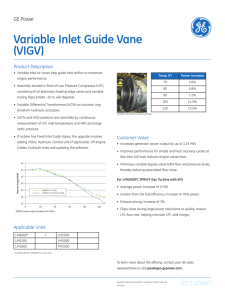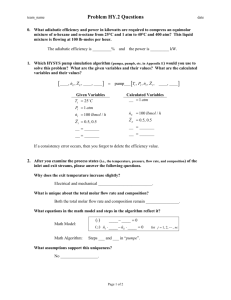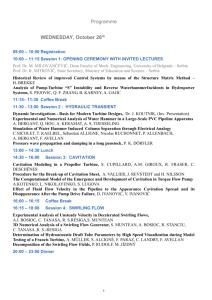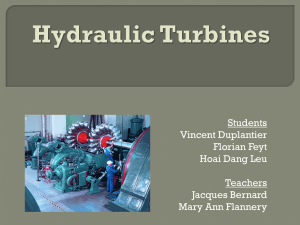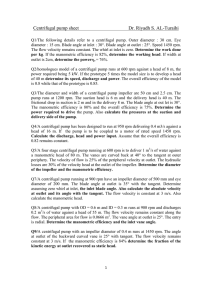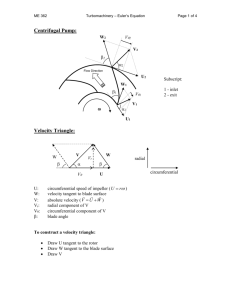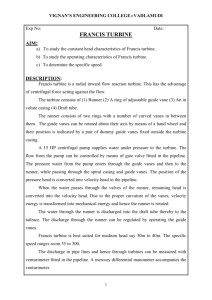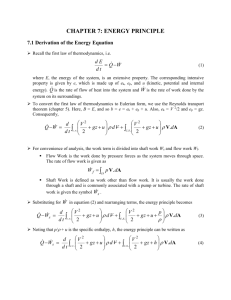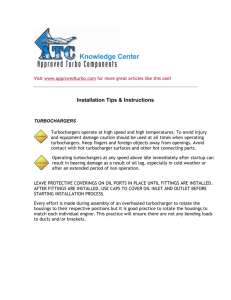Department of Mechanical Eng.
advertisement
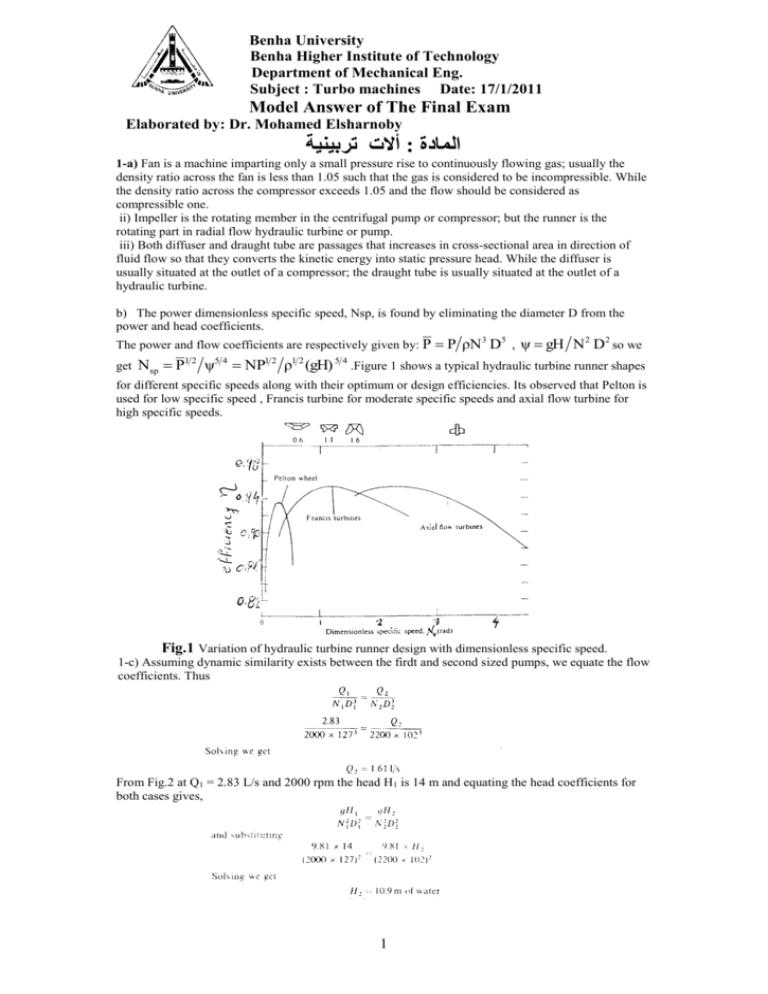
Benha University Benha Higher Institute of Technology Department of Mechanical Eng. Subject : Turbo machines Date: 17/1/2011 Model Answer of The Final Exam Elaborated by: Dr. Mohamed Elsharnoby أالت تربينية: المادة 1-a) Fan is a machine imparting only a small pressure rise to continuously flowing gas; usually the density ratio across the fan is less than 1.05 such that the gas is considered to be incompressible. While the density ratio across the compressor exceeds 1.05 and the flow should be considered as compressible one. ii) Impeller is the rotating member in the centrifugal pump or compressor; but the runner is the rotating part in radial flow hydraulic turbine or pump. iii) Both diffuser and draught tube are passages that increases in cross-sectional area in direction of fluid flow so that they converts the kinetic energy into static pressure head. While the diffuser is usually situated at the outlet of a compressor; the draught tube is usually situated at the outlet of a hydraulic turbine. b) The power dimensionless specific speed, Nsp, is found by eliminating the diameter D from the power and head coefficients. The power and flow coefficients are respectively given by: P get P ρN3 D5 , ψ gH N 2 D2 so we Nsp P1 2 ψ5 4 NP1 2 ρ1 2 (gH) 5 4 .Figure 1 shows a typical hydraulic turbine runner shapes for different specific speeds along with their optimum or design efficiencies. Its observed that Pelton is used for low specific speed , Francis turbine for moderate specific speeds and axial flow turbine for high specific speeds. Fig.1 Variation of hydraulic turbine runner design with dimensionless specific speed. 1-c) Assuming dynamic similarity exists between the firdt and second sized pumps, we equate the flow coefficients. Thus From Fig.2 at Q1 = 2.83 L/s and 2000 rpm the head H1 is 14 m and equating the head coefficients for both cases gives, 1 Fig.2 2-a) A typical pumping system is shown in Figure 3 where Figure 3. Pumping system b) the dependence of pump characteristics on blade outlet angle β 2 are shown on Figures 4 and 5. Figure 4 shows the theoretical dependence between the energy head and the flow rate Q which is given by the equation E U 22 g (QU 2cotβ 2 /gA) Figure 4 : Theoretical characteristics for varying blade outlet angle Figure 5 Actual characteristics for varying blade outlet angle 2 Figure 5 shows the actual dependence of power and head on the flow rate for different β 2 . c) The single pump characteristic is plotted in the figure below along with the characteristics for the two pumps connected in series and in parallel. Since the same pump is used in both cases ; for the series connection the flow rate is the same and the head is doubled while for the parallel connection the head across the pump is the same and the flow rate is doubled. Figure 6: Axial pump characteristics when connected in parallel and series. Series connection Parallel connection At point A both connections give the same head and flow rate and the system characteristics must pass through this point and the point C(0.2) since there is 2m static lift. At operating point A in the above figure Q = 0.48 m3/sec, H = 9.75 For the system curve H = H s + K Q2 But Hs = 2 , therefore H = 2 + 0.48 2 K = 9.75 And then K = 33.64 Hence the system curve is given by : H = 2 + 33.64 Q2 The system curve is parabolic and may be drawn for various flow rates and head as shown in the above figure. The point B is the operating point for a single pump within the system. The single pump operates at point B : Q = 0.4 m3/sec H = 7.4 m 3 3-a) Figure 7 illustrates the system with the velocity triangles. Figure 7 Inlet velocity triangle The hydraulic efficiency is given by: 4 3-b)The hydraulic efficiency is given by P = 4578 kW (this power is delivered to runner) 5 4-a) b) Figure 8 illustrates the change in total pressure loss coefficient and mean deflection on changing the angle of incidence i Figure 8 : cascade mean deflection and pressure loss curves. 6 And substituting for (h2-h1), (h3-h1), the reaction ratio R becomes b) The inlet Mach number should be restricted to an acceptable value . It may be achieved by placing guide vanes at the inlet . Guide vanes at the inlet will impart a whirl component C x1 to the fluid, thus reducing W1 to an acceptable value. This is shown in the figure 9 below. Figure 9: The effect of inlet guide vanes on the inlet relative velocity: (a) at shroud; (b) at hub 7 4-c) The diagram temperature difference is \ = 167.2 degree Therefore U2 = 425.75 m/sec D2 = 0.6776 m The impeller diameter is equal to 0.6776 m The overall loss is proportional to (1-ηc) =(1-0.8). Half of the overall loss is therefore 0.5(1-0.8) = 0.1 and therefore the effective efficiency of the impeller in compression is (1-0.1) = 0.9. = 4.35 To2 = 288 + 167.2 =455.2 K T2 = 379.3 K P2/Po2 = 0.5283 P2 = 232.8 kPa ρ2 =2.138 kg/m3 To find the flow velocity normal to the prephery of the impeller Cx2=σ U2 = 0.9 x 425.75 = 383.2 m/sec The Mach number is one at exit so C 22 γRT2 C22 1.4 287.1 379.2 152415.7 C22 C2x2 C2r2 Cr2 74.66m/sec m 8 A2 0.05012 ρ 2 C r2 2.138 74.66 The impeller depth b at outlet is given by: A b 2 0.023545m πD 2 5-a)If we compress in a single compression from 1 to 5, the isentropic work done is 8 Figure 10 5-b)In a rotor of a turbine or compressor the total relative enthalpy is constant from inlet to outlet i.e. h 01rel h 02rel. W12 W22 h Then 2 2 2 2 2 W W1 Or h1 h 2 2 2 Across the stage the fluid may be considered as incompressible. Therefore ρW12 ρW22 p 01rel p1 and p 02rel p 2 2 2 p p p p Hence h1 h 2 02rel 2 01rel 1 ρ ρ Now along an isentropic process 1 Tds dh dp 0 ρ 1 Therefore dh dp ρ p p Along 1-2s h 2s h1 2 1 ρ p p p p p p Thus h 2 h 2s 01rel 1 02rel 2 2 1 ρ ρ p p 02rel h 2 h 2s 01rel ρ h1 5-c) The reaction ratio R is given by: 9 R φtanβ1 tanβ2 )/2 Where, C φ a U 2ππ r 60 2π 18000 0.18 339.292m/s ec 60 φ 0.530516 tanβ1 tanβ 2 ) 2R 1.8849555 φ o β 2 25 tanβ1 1.4186 U ωr β1 54.82o (i) α 2 β1 54.82o π ρC a D 02 D i2 m 4 p ρ 1.18877kg/ sec RT π 1.18877 180 0.42 2 0.32 m 4 14.52kg/se c (ii) Actual Work λUCa tanβ1 tanβ 2 ) 51182J/kg 51182 904.146kW (iii) m Power required ηs η m ψ λ(tanα 2 tanα1 ) ψ 0.4446 C12 T01 T1 312.62K 2C P T03 363.55K T02 γ P02 1 0.88(363.55 312.62)/ 312.62 γ 1 Po1 P02 1.598 (iv) Po1 Ca W cosβ1 M1 1 a1 γRT M1 0.91 (v) 10
